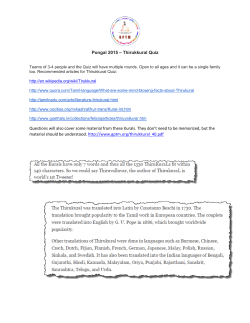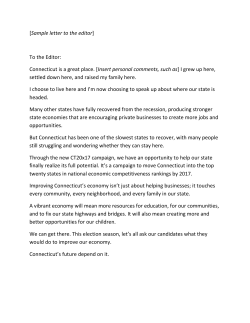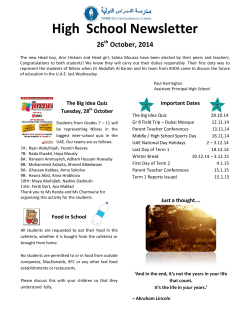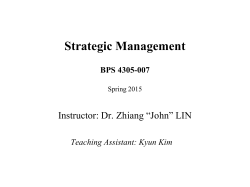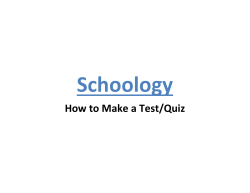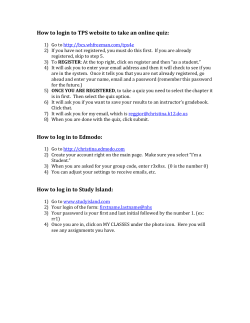
Section N70 - eCampus - University of Connecticut
Summer Semester 2015 S page y l l a b u 1! o f 1! 6 s Class info Assessment Course Outline Academic Honesty readings, class procedures, percentage breakdown of the calendar and deadlines University policy on academic course requirements course Page 2 Page 3 honesty and original work Pages 4-6 Page 7 MAST 1200 SECTION N70 INTRODUCTION TO MARITIME CULTURE University of Connecticut - Avery Point Three credits. A study of history and literature to understand the international maritime culture that links peoples, nations, economies, environments, and cultural aesthetics. CA 1 (Arts and Humanities) Course description: Throughout history, the sea has served as a highway, a source of food, an arena for warfare, and a stage for discovery. The Atlantic both divides and connects the lands that surround it. The Pacific served as a blank slate for European imperialists while harboring ancient maritime societies. Through this course, students will consider the ocean itself as a natural environment whose fate is entwined with that of the human actors we will study. These actors have included sailors, whalers, slaves, pirates, fishermen, shore side residents, naval officers, merchants, politicians, novelists, Dr. Steven H. Park Voice: 1.860.405.9057 Email: Park@uconn.edu (please use MAST 1200 as your subject line) Web: http://huskyct.uconn.edu http://mast1200.uconn.edu Office: ADC 317A Avery Point Campus Groton, CT I will be out on 4 July MAST 1200 Syllabus University of Connecticut Avery Point Campus Summer Semester 2015 page MAS T 1 2 0 0 DR . STE VE N H . PARK scientists, and policy-makers. Humans have responded to the ocean, the largest object on earth, with a mixture of emotions: wonder, fear, comfort, terror, spirituality, practicality, playfulness, absolute seriousness, foreboding, a sense of inadequacy, great joy. Their response to what Herman Melville calls the “watery part of the world” was often written down, for humans are driven to put their experience of the ocean into words. This course will explore maritime history with attention to the international linkages afforded by the ocean, the distinctive cosmopolitan maritime culture created at sea, and the literature that resulted as humans interacted with the ocean. The following themes will be woven throughout the topic areas covered in the course: • technology and the effects of technological change • nautical language, archetypes, and superstition • social history: the role of class, race, and gender in maritime history • naval strategy, policy, and action • exploration and imperialism • the balance of recreation and work • the experience of seafarers-coming of age, or the exploration of the individual-the imagination • ethics of survival scientists, and policy-makers. Humans have responded to the ocean, the largest object on earth, with a mixture of emotions: wonder, fear, comfort, terror, spirituality, practicality, playfulness, absolute seriousness, M AST 120a 0 Syllabus foreboding, sense of ! 2 o f 1! 6 Dava Sobel 1996, 2007 Walker & Company, New York ISBN-10: 080271529X $10.00 softcover Available from the UConn COOP. All other readings are in HuskyCT under “Library Resources.” Course Requirements This course is built upon readings, including a mixture of primary documents, literature, and secondary material, and film. The course will be centered around the discussion of assigned readings and maritime films. Midterm and final exams: 40% short answer; 60% essay Writing assignments: ·Response papers such as relating sea music to themes previously covered in class ·Short research paper such as an investigation of the definition, etymology, and lore of a maritime term An aesthetic response such as a poem, dramatic production, or personal essay University of Connecticut Avery Point Campus Summer Semester 2015 page ! 3 o f 1! 6 A V ERY P O IN T A C A D EM IC C EN TER Assessment Grades will be determined on the basis of class participation, completed reading, exams, and writing assignments. Class participation and completed reading are central to an introductory course such as this one, so they will compose 20% of the grade. As noted above, the midterm and final exams will be 40% short answer and 60% essay. There will also be quizzes in HuskyCT. Other writing assignments are described above. The grade breakdown follows: • 20% class participation and completed reading • 5% quizzes given during regular class time • 10% response papers (see above) • 10% short research paper (see above) • 5% aesthetic response (see above) • 20% midterm • 30% final Avery Point Academic Center The Academic Center is available to the Avery Point community (free of charge), including students, staff, and faculty, for individual and group study; tutoring; development of reading, writing, math, and computer skills; and other assistance with academic or related subjects. *images from APAC website MAST 1200 Syllabus University of Connecticut Avery Point Campus Summer Semester 2015 page ! 4 o f 1! 6 MAS T 1 2 0 0 C OUR S E OUTL I NE Norse long house recreation at L’Anse Aux Meadows, Newfoundland and Labrador, Canada image from Wikimedia Commons 1 – Introduction - 1 June 2015 Objectives: Upon completion of this module, students will be able to: • Identify the main themes of this course and the type of questions we will address: o o o o o the physical entity of the ocean the physical geography terminology What is the ocean? How do different people think differently about it? How have people thought differently about the ocean over time? Activities: • Introductory lecture • Read through syllabus- have a syllabus quiz 2 – Exploration and Imagination due 5 June 2015 @ 10:00 AM Objectives: Upon completion of this module, students will be able to:` • Compare and contrast examples of early exploration, such as the Phoenicians, Vikings, Polynesians, Chinese, etc. (Norse Evidence Web Assignment) • Explain the European discovery of sea routes. • Students will be able to explain why understanding wind patterns was paramount. (Quiz 1 and midterm exam) • Discuss decking and other newer technologies, the limits of muscle power, and improved navigation techniques (Quiz 1 and midterm exam) • Identify some basic nautical language, archetypes, and superstition. (Quiz 1 and midterm exam) • Explain why the stories of Jonah and the Ancient Mariner are so universal. (discussion #1) Activities: Read 100 pages (found in ARES/Google books (free of charge). MAST 1200 Syllabus University of Connecticut Avery Point Campus Summer Semester 2015 page ! 5 o f 1! 6 MAS T 1 2 0 0 C OU R SE OUTL I NE The Front of the Wren building at the College of William and Mary in Williamsburg, VA image from Wikimedia Commons J.H. Parry, The Discovery of the Sea Introduction: One Sea and Chapter 1 A Reliable Ship James Axtell, Beyond 1492 : Encounters in Colonial North America Chapter 2 Imagining the Other Samuel Taylor Coleridge, “The Rime of the Ancient Mariner” The Story of Jonah 27 46 22 5 1. Watch the introduction of the Exploration and Imagination lesson through a brief lecture on lecture capture 2. Complete the Norse Evidence Web Assignment. 3. Post a suggestion for a quiz question for Quiz 1 on the discussion board. 4. Participate in Discussion #1: What ship types permitted blue water travel? If Chinese and Arab peoples had sophisticated ship technology, why were the Europeans the first to reach distant lands? Discuss importance of trade and the key discovery of sea routes. Why are the stories of Jonah and the Ancient Mariner so universal? What happens to these characters when they go out on the sea? How do they change? Why? 3 – The Atlantic Ocean: Exploration, Imperialism, and Trade – 9 June 2015 @ 10:00 AM Objectives: Upon completion of this module, students will be able to: 1. Summarize the basic formation of the early-modern, post-contact, pre-industrial Atlantic world. (Quiz #1 and midterm exam) 2. Discuss the economic and cultural links and interdependencies among places around its rim including the slave trade and its incorporation into Euro-American economic systems. (discussion #2) 3. Identify way in which European maritime exploration can be seen as both a great achievement while also wreaking great destruction. Explain how it is viewed in these different literary pieces. Explain the racial and ethnic elements of exploration and imperialism. (discussion #2) 4. Trace imperialism and those trade routes that developed from early European exploration ---and the human response to these. (Quiz #1 and midterm exam) MAST 1200 Syllabus University of Connecticut Avery Point Campus Summer Semester 2015 page ! 6 o f 1! 6 MAS T 1 2 0 0 C OUR S E OUTL I NE A lateen-rigged caravel, Caravela Latina used for Atlantic exploration by Europeans from the Iberian Peninsula image from Wikimedia Commons Activities: Read 113 pages (found in ARES) Sidney Mintz, Sweetness and Power Chapter 2 Production Daniel Vickers, Farmers and Fishermen Chapter 4 Fishermen 1675-1775 54 59 1. Watch The Atlantic Ocean: Exploration, Imperialism, and Trade through a brief lecture on lecture capture 2. Participate in Discussion #2: Until recently, historians celebrated European maritime achievements as great political, technical, and physical feats in the history of mankind. How has this changed in the last generation? Use reading, lectures, videos, and class activities to cite examples and analysis (expansion of African slavery and treatment of indigenous peoples by germs and Europeans) 3. Complete Quiz #1. 4 – The Atlantic Ocean as Moat and Bridge – 12 June 2015 @ 10:00 AM Objectives: Upon completion of this module, students will be able to: 1. Identify some of the effects of technology on ocean navigation. (Quiz 2 and midterm) 2. Compare and contrast the stellar/lunar solutions with the technology-based solution of making a portable, seaworthy timepiece. Explain the political and technical challenges Harrison faced. (Quiz 2 and midterm) 3. Explain the “Atlantic Paradox.” Identify some of the implications of the Atlantic paradox for European settlers/immigrants, native American Indians, and slaves of Africa ancestry. (Quiz 2 and midterm) Activities: Read 198 pages (found in ARES and book purchased ahead of time) Benjamin Labaree, "The Atlantic Paradox," article in The Atlantic World of Robert G. Albion Dava Sobel, Longitude 175 MAST 1200 Syllabus University of Connecticut Avery Point Campus 23 Summer Semester 2015 page ! o f 1! 6 7 MAS T 1 2 0 0 C OUR S E OUTL I NE The last, surviving, wooden whaler in the world The Charles W. Morgan at Mystic Seaport, Mystic, CT image from Wikimedia Commons 1. Watch the Atlantic Ocean as Moat and Bridge through a brief lecture on lecture capture 2. Watch Nova’s Lost at Sea: the Search for Longitude to better understand the technical and political aspects that made this such a difficult problem to solve. Streamed through ARES in HuskyCT. 3. Participate in an open discussion #3 about what you have read so far in class. Interact with other students’ reactions on the discussion board in HuskyCT. What surprised you? What has re-enforced what you already knew?. 4. Post a suggestion for a quiz question for Quiz 2 and a longer, more substantive question for the midterm on the discussion board. 5 – Whaling -16 June 2015 @ 10:00 AM Objectives: Upon completion of this module, students will be able to: 1. Explain why Moby Dick has been called the “Great American Novel.” Identify some of the timeless themes. (Quiz #2 and midterm) 2. Identify some of the elements of the Essex tragedy that made their way into Melville’s classic novel. (Discussion #4) 3. Compare and contrast Whaling in Australia and New Zealand with New England practices. Identify sustainability – related issues. (Quiz #2 and midterm) Activities: Read 89 pages (found in ARES) Richard Ellis, Men and Whales Bay Whaling in Australia and New Zealand & Sperm Whaling Nathanial Philbrick, In the Heart of the Sea: The Tragedy of the Whale Ship Essex Preface and Chapter 1 Herman Melville, Moby-Dick (the pulpit, the sermon) MAST 1200 Syllabus University of Connecticut Avery Point Campus 38 34 17 Summer Semester 2015 page ! 8 o f 1! 6 MAS T 1 2 0 0 C OUR S E OUTL I NE The L. A. Dunton at Mystic Seaport was the “sister” vessel to the We’re Here used in the film Mystic Seaport, Mystic, CT image from Wikimedia Commons Watch the Whaling lesson through a brief lecture on lecture capture Watch Moby Dick (the older Gregory Peck, 1956 one) in HuskyCT through ARES stream. Complete quiz #2 Participate in Discussion #4. Herman Melville writes, “To produce a mighty book, you must choose a mighty theme. No great and enduring volume can ever be written on the flea, though many there be who have tried it.” Do you agree with Melville? Why do whales and whaling attract so much literary interest? What is it about them that is so appealing? Is this the “Great American Novel?” What are some of the timeless themes of Moby Dick? How do you think the Essex influences Melville? How was whaling in the South Pacific different from what Melville describes? Also discuss the economic importance of whaling and whaling technology. 5. Review for midterm exam in discussion tool. 1. 2. 3. 4. 6 – Fisheries – 19 June 2015 @ 10:00 AM Objectives: Upon completion of this module, students will be able to: 1. Identify different fishing technologies. Grand Banks fishery (hand- and long-lining; dory fishing; ice; growth of markets) (Quiz 3 and final exam) 2. Explain the differences between the history of inshore and offshore fisheries highlighting the statistics re: death and injury rate in the fisheries. (Quiz 3 and final exam) 3. Fishing has produced a very different literature than whaling: Captains Courageous and The Old Man and the Sea are very different books from Moby-Dick. Students will be able to explain why this is the case. Identify what is it that is inherent in these two industries that causes such a difference in the literature produced about them. (Quiz 3 and final exam) Activities: Read 196 pages (found in ARES and through Google books (free of charge). Rudyard Kipling, Captains Courageous Chapters 1-5 Mark Kurlansky, Cod: A Biography of the Fish That Changed the World Chapters 3-4 MAST 1200 Syllabus University of Connecticut Avery Point Campus 167 29 Summer Semester 2015 page ! 9 o f 1! 6 MAS T 1 2 0 0 C OUR S E OUTL I NE Anne Bonny from a Dutch version of Charles Johnson’s book of pirates image from Wikimedia Commons 1. 2. 3. 4. Watch the Fisheries lesson through a brief lecture on lecture capture Take the midterm exam. Watch The Old Man and the Sea and Perfect Storm through ARES streaming in HuskyCT. No discussion, quiz, or paper this module (because of the midterm exam) --but also we do not want to discuss Captains Courageous until everyone has finished the book. 7 -- Life at Sea, or Coming of Age and the Exploration of the Individual – 23 June 2015 @ 10:00 AM Objectives: Upon completion of this module, students will be able to: 1. Identify who went to sea and why? Explain the culture of life and work at sea ---and how individuals grew and changed at sea. (Quiz 3 and final exam) 2. Describe the culture of life and work at sea. Explain how did the individual grow and change as a result of being on the ocean? Identify some of the music, technology, recreation, and work at sea. (Quiz 3 and final exam) 3. Compare and contrast the life of piracy with the life of a merchant seafarer, privateer, or navy sailor. Compare and contrast the life of a most eighteenth-century women on land and the self-liberation of Bonny and Read. (Discussion #5) Activities: Read 220 pages (found in Google books and ARES) Rudyard Kipling, Captains Courageous (continued from last week) Chapters 6-10 (finish the book) Bolster, W. Jeffrey. Black Jacks : African American Seamen in the Age of Sail Chapter 3 - The Way of A Ship 154 33 Margaret Creighton and Lisa Norling, eds., Iron Men, Wooden Women: Gender and Seafaring in the Atlantic World, 1700-1920 Chapter 1 Liberty beneath the Jolly Roger: the Lives of Anne Bonny and Mary Read, Pirates 33 MAST 1200 Syllabus University of Connecticut Avery Point Campus Summer Semester 2015 page 1! 0 o f 1! 6 MAS T 1 2 0 0 C OUR S E OUTL I NE Mystic Seaport as viewed from the Mystic River image from Wikimedia Commons • • • • • Watch the Life at Sea, or coming of Age and the Exploration of the Individual lesson through a brief lecture on lecture capture Watch Captains Courageous through stream in HuskyCT through ARES Post a suggestion for a quiz question for quiz #3 on the discussion board. Participate in Discussion #5. In what ways have authors used the sea as a “proving ground” for the individual? For Harvey? For Anne and Mary? What opportunities did seafaring life provide for black men? How did Anne and Mary practice a form of “self-liberation” that made their lives so very different from most eighteenth-century women in the Atlantic world? Role play: the scene is the trail of Bonny and Read. We will divide the class into two groups and assign the role of Admiralty court judge, defense team for the female pirates, prosecutor representing the interest of the Crown, jury members from various backgrounds: Merchant seafarer/African American able seaman/Common seafarer from a privateer/Sea Officer (lieutenant commander) in Royal Navy/Shipmaster from a merchant vessel Students will contribute varying perspectives on the plight of Bonny and Read. 8 – Ports and Coastal Seafaring Communities 26 June 2015 @ 10:00 AM Objectives: Upon completion of this module, students will be able to: 1. Explain the development of port cities and coastal seafaring communities. (Final exam) 2. Identify people who worked on the sea from the shore and also those who supported seafarers. (Final exam) 3. Compare and contrast the lives of men and women in seafaring communities. Explain the role of gender in their work and their families. (discussion question #6) Activities: Read 129 pages (available through ARES) Sara Orne Jewett, The Country of the Pointed Firs Chapters 1-5 John Millington Synge, “Riders to the Sea,” The Aran Islands, Part I 21 13 63 Lisa Norling, Captain Ahab Had a Wife : New England Women & the Whalefishery, 1720-1870 Chapter 2 MAST 1200 Syllabus University of Connecticut Avery Point Campus 32 Summer Semester 2015 page 1! 1 o f 1! 6 MAS T 1 2 0 0 C OUR S E OUTL I NE 26th President of the United States Theodore Roosevelt image from Wikimedia Commons 1. Introduce the Ports and Coastal Seafaring Communities lesson through a brief lecture on lecture capture. 2. Watch The Man of Aran film through HuskyCT in ARES stream. 3. Complete quiz #3. 4. Participate in Discussion # 6. How is the experience of the sea different for people working from the shore? Is it profoundly different from the experience of those who went out to sea to make their living? What was the experience of those who supported seafarers from the shore? Are there genderbased differences? What are they, and why are they different? Do those gender-based differences change over time? Who writes about these experiences: those involved or outsiders? Why? 5. Start working on upcoming paper assignment. 9 -- Maritime Frontier and Maritime Encounters Overseas – 30 June 2015 @ 10:00 AM Objectives: Upon completion of this module, students will be able to: 1. Explain the origins of U.S. Imperialism and A. T. Mahan’s and President Theodore Roosevelt’s roles in navalist policy. (discussion #7 and final exam) 2. Describe some encounters between sailors and native people in the South Pacific. (discussion #7 and final exam) 3. Identify A.T. Mahan and explain how he shaped maritime policy. After American independence and the Monroe Doctrine, describe where sailors went and whom they encountered. Describe the “new” New World. (discussion #7 and final exam) Activities: Read 88 pages (found in ARES and Google books, free of charge) James Butler, Sailing on Friday: The Perilous Journey of America's Merchant Marine Chapter 8 Somerset Maugham, “Vessel of Wrath” Alfred Thayer Mahan, The Influence of Sea Power upon History, 1660-1783 Preface and Introductory MAST 1200 Syllabus University of Connecticut Avery Point Campus 22 38 28 Summer Semester 2015 page 1! 2 o f 1! 6 MAS T 1 2 0 0 C OUR S E OUTL I NE Sabino (1908 steamship) at Mystic Seaport, Mystic, CT image from Wikimedia Commons 1. Introduce the Maritime Frontier and Maritime Encounters Overseas lesson through a brief lecture on lecture capture. 2. Watch Mutiny on the Bounty and the Amistad Mutiny through HuskyCT in ARES. 3. Submit a short two-page research paper (480-600 words) on the definition, etymology, and lore of a maritime term. It will be harder to get at the etymology of the word. You have access to the full OED through the library’s website. Please upload to SafeAssign. 4. Participate in Discussion #7. What were the effects of South Seas encounters on both sailors and islanders? How did their encounter with the South Seas shape the imagination of sailor/writers such as Jack London? Why has the Bounty story been the inspiration for so many books and movies? 10 -- Sail to Steam – 3 July 2015 @ 10:00 AM Objectives: Upon completion of this module, students will be able to: 1. Compare and contrast the experience of sailors under sail and steam power. (Discussion #8 and Final Exam) 2. Identify changes in technology and its effect on sailors. (Discussion #8 and Final Exam) 3. Explain what was lost because of this change as well as what was gained. (Discussion #8 and Final Exam) 4. Identify ways in how vessels are portrayed before and after the shift in technology. (Discussion #8 and Final Exam) Activities: Read 75 pages (available in ARES) John Malcolm Brinnin, The Sway of the Grand Saloon; a Social History of the North Atlantic Sections 1 - IV Eugene O’Neill, “The Hairy Ape” MAST 1200 Syllabus University of Connecticut Avery Point Campus 50 25 Summer Semester 2015 page 1! 3 o f 1! 6 MAS T 1 2 0 0 C OUR S E OUTL I NE Sabino (1908 steamship) at Mystic Seaport, Mystic, CT image from Wikimedia Commons 1. Watch the Sail to Steam lesson through a brief lecture on lecture capture. 2. Watch the privately-produced 1929 film Around Cape Horn filmed by Irving Johnson during his 1929 voyage on the Barque Peking 3. Participate in Discussion # 8. What were the changes to work and workers at sea as vessels were converted from sail to steam? How did writers respond to this profound change? Huge, understaffed clipper ships are the last gasp of the dying age of sail; discuss changes to work and workers at sea. Incorporate the leadership style of Johnson’s skipper on the Peking. 11 -- Development of Ocean Science and the Oceans as Global Commons 7 July 2015 @ 10:00 AM Objectives: Upon completion of this module, students will be able to: 1. Explain the use of science to try to understand and control fishery fluctuations. (final exam) 2. Compare Europe’s rising nineteenth and twentieth-century nationalism with increasing internationalism in marine policy. (final exam) 3. Identify some of the early voyages of scientific discovery related to the ocean, ocean currents, temperatures, salinity, tides, wave activity, and earthquakes. (final exam) 4. Outline the basic accomplishments of the Law of the Sea conventions. (debate, final exam) Activities: Read 75 pages in ARES Margaret Deacon, Scientists and the Sea, 1650-1900 : A Study of Marine Science Chapters 9 & 10. Helen Rozwadowski, The Sea Knows No Boundaries : A Century of Marine Science under Ices Introduction and Chapter 1 MAST 1200 Syllabus University of Connecticut Avery Point Campus 34 41 Summer Semester 2015 page 1! 4 o f 1! 6 MAS T 1 2 0 0 C OUR S E OUTL I NE RMS Titanic April 1912 image from Wikimedia Commons 1. Introduce the Development of Ocean Science and the Oceans as Global Commons lesson through a brief lecture on lecture capture. 2. Listen to the podcast Who owns the oceans? By Josh Clark in ARES in HuskyCT. 3. Participate in a debate about the pros and cons for the United States to ratify the Convention (signed in 1994, but not ratified). 4. 12 – Ethics of survival – 8 July 2015 @ 10:00 AM Objectives: Upon completion of this module, students will be able to: 1. Discuss the issues of class and privilege and the role it played in ocean travel. (final exam) 2. Explain why shipwreck stories continue to intrigue us. (final exam) 3. Explain what it is about shipwreck stories that captures our imagination, that is eternal and transcends culture. (final exam) Activities: Read 22 pages (available in ARES) Stephen Crane, “The Open Boat” 65 1. Watch the Ethics of survival lesson through a brief lecture on lecture capture. 2. Watch 1997 film “Titanic” 3. Study the survivor chart for the Titanic. Which group had the highest likelihood of survival? Which had the least? 4. Submit final one-page (280-300 words) response paper. What was your favorite topic about which to learn in this class? Why? Which did you like least? Why do you think that is the case? What would you like to see added to this class that we did not cover? Please submit your paper to SafeAssign. MAST 1200 Syllabus University of Connecticut Avery Point Campus Summer Semester 2015 page 1! 5 o f 1! 6 MAS T 1 2 0 0 C OUR S E OUTL I NE 13 – Poetry – 9 July 2015 @ 10:00 AM Objectives: Upon completion of this module, students will be able to: 1. Explain how authors have used the sea as a symbol. (discussion #9 & final exam) 2. Compare sea poetry with other forms of literature. (discussion #9 & final exam) 3. Discuss why the sea such an inspiration, even for an inland poet such as Emily Dickinson. (discussion #9 & final exam) Activities: Read 17 pages (available in ARES) T.S. Eliot “Dry Salvages” 9 Emily Dickinson “I started early, took my dog” and “Wild Nights!” 2 Robert Hayden “Middle Passage” 6 1. Watch the poetry lesson through a brief lecture on lecture capture. 2. Discussion #9: How is the sea used as a symbol in these works? How is creating poetry of the sea different from creating other forms of literature? Why is the sea such an inspiration, even for an inland poet such as Emily Dickinson? Summary – 10 July 2015 @ 10:00 AM Review for the final exam. We will review for the final in the discussion tool. The importance of the oceans today as reflected in literature of the sea Themes/questions to include: What forms of sea literature are being written now? Why? How are they different from what was written before? Summary of all themes and questions discussed in the course. Final Exam 10 July 2015 @ 10:00 AM The above schedule, policies, and assignments in this course are subject to change in the event of extenuating circumstances or by mutual agreement between the instructor and the students. MAST 1200 Syllabus University of Connecticut Avery Point Campus Summer Semester 2015 page 1! 6 o f 1! 6 A C A D EM IC M IS C O N D UC T A T UC O N N What is considered academic misconduct for undergraduate students? Academic misconduct includes, but is not limited to: • Providing or receiving assistance on academic work (papers, projects, examinations) in a way that was not authorized by the instructor • Any attempt to improperly influence (bribery, threats) any member of the faculty, staff, or administration of the University in any matter relating to academics or research • Plagiarism • Doing academic work for another student • Presenting the same or substantially the same papers Avery Point offers 4-year bachelor’s degree in Maritime Studies Maritime Studies is an interdisciplinary undergraduate major that embraces the liberal arts as the foundation for exploring humankind's critical and continually evolving connections with or projects in two or more courses without the explicit permission of the instructors • Situations where one student knowingly assists another student in committing an act of academic misconduct, and any student doing so will be held equally accountable for the violation Why does the University of Connecticut have a policy regarding academic integrity and academic misconduct? The University of Connecticut is an institution that is dedicated to learning. Through the UConn Creed, students are encouraged to the world's waterways and watersheds. The Maritime Studies Program combines rigorous liberal arts training in recognized humanities and social science disciplines such as History, English, Geography, Economics, Political Science and Anthropology with specialized courses, interdisciplinary practice both personal and academic integrity. Integrity, honesty, and fairness are the foundation of the educational process. Academic misconduct violates these principles, and • Taken from http:// www.community.uconn.edu/ academic_integrity_students_faq.ht ml If you are suspended or expelled from the University as a result of academic misconduct, a notation of suspension or expulsion will be put on your transcript. seminars, and research and internship opportunities that focus on issues, traditions, and problems that influence life in maritime regions.courses, interdisciplinary seminars, and research and internship opportunities that focus on issues, traditions, and problems that influence life in maritime regions. MAST 1200 Syllabus University of Connecticut Avery Point Campus
© Copyright 2025
